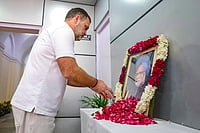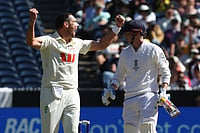Though he had resigned as defence minister on 11 April 1987, it was only three months later — on 15 July 1987, infuriated by Arun Nehru, Arif Khan and V.C. Shukla’s expulsions — that V.P. Singh quit the Congress. During the months when he was hesitating to do so, S. Jaipal Reddy, spokesperson for the Janata Dal for most of its brief existence, recalled once asking him why he remained with the party — having fallen out so bitterly with Rajiv Gandhi that his future in it was doomed. Reddy maintained that VP replied with great candour. ‘If I join the Opposition, I’ll have to abandon the social groups I’ve always been close to and embrace others with which I’ve had little to do so far,’ he said.
By social groups, of course, VP meant castes — though he would never have realised at the time how crucially the new groups he was about to embrace would shape his political legacy. As many political scientists have noted, and as VP himself found out in all the elections he fought as a Congress candidate, the Congress’s electoral base in north India comprised a ‘coalition of extremes’ — the bulk of its voters were either upper castes (Brahmins, Kshatriyas and Vaishyas) or Scheduled Castes (the Dalits or traditional untouchables), apart from the Muslims. This odd combination of upper castes and the lowliest castes had been forged in pre-Independence times. While the far-better-educated upper castes naturally dominated the freedom movement and were the Congress’s main supporters, the Scheduled Castes were attracted to it mainly due to Mahatma Gandhi’s crusade against untouchability.
The group left out of the Congress fold in north India were the Shudras — the bulk of peasants and rural service providers who form the mainstay of rural society, many of whom (though, importantly, not all) came to be classified as the OBCs. Historically, they, too, had been discriminated against by the upper castes, but to a lesser extent than the Dalits. Though the peasants among them were big gainers from the Congress’s land-reform drive — the abolition of zamindari and the imposition of ceilings on large landholdings — in north India they still stayed away from the party, partly because the reforms were not implemented rigorously enough but mainly because the upper-caste leaders who dominated the Congress organisation resisted sharing power with them. Even in the breakaway parties Indira Gandhi formed after splitting the Congress in 1969 and again in 1977-78, the upper caste–Scheduled Caste combination remained her bulwark of support in north India.

Though their numbers were formidable — their nationwide population estimated at different times between 35 and 52.4 per cent — the OBCs, especially in north India, due to poor political awareness, would initially scatter their votes, which, in turn, enabled the Congress to keep winning elections, despite the fact that the Brahmins, Kshatriyas and Vaishyas together averaged merely 20 per cent of the population, with Dalits about 15 per cent and Muslims another 13-15 per cent. The personal popularity of Jawaharlal Nehru and Indira also helped the Congress garner votes, irrespective of caste.
The politicised sections of the OBCs, however, mostly supported the Socialist Party and its successor, the SSP, as VP had vividly observed while fighting his first election from Soraon in 1969. The socialists’ main appeal for OBCs stemmed from their avowal that if elected to power, they would reserve 60 per cent of all government jobs for them, embodied in a slogan much heard in the SSP’s (abbreviated to ‘Sasopa’ in Hindi) heyday, ‘Sasopa ne baandhi gaant/Pichhdey pawey sau mein saat’ (The SSP has pledged amen/for backwards, it’s six out of ten)’. No doubt the OBCs realised that such reservation would only benefit a minuscule number among them, since government jobs comprised a very small slice of the total number of available jobs. But with OBC representation in government services extremely low — in the Central government, when VP took over, it was 14.5 per cent — and such jobs providing prestige, security and power, even as private industry in the north Indian states remained moribund, the slogan resonated strongly with them.
The scenario differed considerably in south and west India, where, unlike in the north, the Congress drew sizeable support from the leading peasant castes. In these states, upper castes are even fewer than in north India, their population as a percentage of the total mostly in single digits. They thus matter far less electorally, leaving the Congress no choice but to woo other castes as well. Yet, here too, as in the north, the upper castes — especially the Brahmins — given their millennia-old tradition of education, held the bulk of government jobs. But with the OBCs being in greater numbers and better organised than in the north, they had long ago begun protesting this imbalance. In response, even before Independence, the British governments of the Bombay and Madras presidencies, as well as the princely states of Kolhapur (the first to introduce job reservations of any kind, in 1902), Mysore, Cochin and Travancore, acknowledging the validity of the protests, had begun setting aside quotas in government jobs for them.
Post-Independence, the Congress governments in these states had continued with the quotas. In most north Indian states, however, the only reservations were for Dalits and the tribals; the Congress saw no reason to extend them to the OBCs, who didn’t vote for them anyway. They also knew that doing so would surely annoy their upper-caste supporters, whose job opportunities would shrink.
But on the recommendation of an advisory committee to the constituent assembly, the Indian Constitution had included an article — Article 340 — which authorised appointing a commission ‘to investigate the conditions of socially and educationally backward classes … and the difficulties under which they labour, and to make recommendations as to the steps that should be taken … to remove such difficulties and improve their condition’. Accordingly, in January 1953, such a commission was set up, chaired by former freedom fighter, social reformer and writer Dattatreya Balakrishna (Kaka) Kalelkar, which submitted its report two years later, listing 2,399 castes countrywide that it considered OBCs and recommending 25-40 per cent reservation for them in different categories of Central government service.
Yet its recommendations were never implemented, partly because, in a bizarre afterthought, Chairman Kalelkar undermined his own report, adding to it a twenty-three-page covering letter pointing to its several purported shortcomings, but also because the Congress feared upsetting its upper-caste voters in north India. Yet, anxious to not lose the OBC votes it drew in the south and the west (which it might have if it dismissed the report entirely), the Congress found a middle path, declaring that while there would be no OBC quota in Central government jobs, state governments were free to set up their own commissions to identify state-level OBCs and reserve jobs for them if they wanted. Thereafter, over the next two decades, ten state governments (including some of those that already had OBC reservations dating from before Independence) set up fifteen such commissions, all of which acknowledged that reservations for OBCs was necessary and set varying quotas for them, ranging from 5 per cent (Punjab) to 50 per cent (Karnataka), which their state governments mostly accepted. Significantly, these ten included all the southern and western states —Tamil Nadu, Karnataka, Kerala, Andhra Pradesh, Maharashtra and Gujarat — but only two of the north Indian, Hindi-speaking ones — Bihar and UP. Even in Bihar, it was not a Congress government but one of the half a dozen governments that ruled during the political flux of 1967-72 that took the step, setting up the Mungeri Lal Commission — named after its chairman, a state Vidhan Parishad MLC at the time — in June 1971.
Though the bickering of its leaders destroyed the SSP — as it did the other socialist party, the PSP — the OBC reservation idea long outlived it. Some former socialists joined the Congress, especially in the 1960s; others — once Charan Singh quit the Congress and made another political alternative available — preferred to join him, since his electoral base comprised mainly farmers, many of whom were also OBCs. They continued to keep the OBC reservation demand alive.
When the Janata Party was formed after the Emergency, both Charan Singh’s BLD and the remnants of the socialist parties joined it, cooperating closely thereafter, further consolidating the OBCs politically. Thus, while the Janata Party’s victory in the March 1977 general elections was no doubt a reassertion of democracy against Indira’s dictatorship, it was also seen in north India as a victory of the OBCs over the upper-caste–Scheduled Caste combine.
The Janata Party’s election manifesto had promised to implement the Kalelkar Commission report’s proposals, but eventually, in January 1979, given the report’s shortcomings and the tussles within the party, it decided to set up a new commission to repeat the effort. As chairman of the commission, it appointed Bindeshwari Prasad Mandal, who had been Bihar’s chief ministerfor a fleeting forty-seven days during the political churn of 1967-72. In its report, which proved seminal in VP’s career, the five-member Mandal Commission listed 3,743 castes across the country as OBCs and made a host of recommendations for their uplift — the most important of them being reserving for them 27 per cent of jobs across all categories of Central government service and in all Central government-run technical and professional educational institutions.
Why 27 per cent? The Mandal Commission report maintained that according to its calculations based on the last caste census held in 1931 (the censuses thereafter avoided enumerating specific castes), the country’s OBC population was 52.4 per cent and, ideally, the community’s share of government jobs should match that figure. But it also noted a crucial legal impediment — the 1963 Supreme Court judgment in the case of Balaji versus the State of Mysore, which had ruled that reserved quotas had to be less than a total of 50 per cent. Since, at the Central level, the Scheduled Castes had already been allotted a 15 per cent quota and the Scheduled Tribes another 7.5 per cent, the OBCs could not be given more than 27 per cent.
The Balaji judgment had also decreed that OBCs should not be identified by caste alone, though caste could be one of the yardsticks defining backwardness. Accordingly, the Mandal Commission used levels of education and income as indicators too, to determine which castes to list as backward, though in computing the final ‘backwardness’ score of each caste, social backwardness — being looked down upon by other castes and such — was given more weight than educational backwardness or economic deprivation.
(Excerpted from ‘The Disruptor: How Vishwanath Pratap Singh Shook India’ by Debashish Mukerji, with permission from HarperCollins India. Debashish Mukerji has been a journalist for nearly 40 years and has written on Uttar Pradesh and national politics.)





















